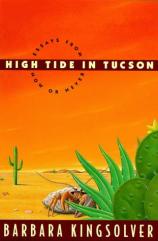Excerpt
Excerpt
High Tide in Tucson

A hermit crab lives in my house. Here in the desert he's hiding out from local animal ordinances, at minimum, and maybe even the international laws of native-species transport. For sure, he's an outlaw against nature. So be it.
He arrived as a stowaway two Octobers ago. I had spent a week in the Bahamas, and while I was there, wishing my daughter could see those sparkling blue bays and sandy coves, I did exactly what she would have done: I collected shells. Spiky murexes, smooth purple moon shells, ancient-looking whelks sand-blasted by the tide--I tucked them in the pockets of my shirt and shorts until my lumpy, suspect hemlines gave me away, like a refugee smuggling the family fortune. When it was time to go home, I rinsed my loot in the sink and packed it carefully into a plastic carton, then nested it deep in my suitcase for the journey to Arizona.
I got home in the middle of the night, but couldn't wait till morning to show my hand. I set the carton on the coffee table for my daughter to open. In the dark living room her face glowed, in the way of antique stories about children and treasure. With perfect delicacy she laid the shells out on the table, counting, sorting, designating scientific categories like yellow-striped pinky, Barnacle Bill's pocketbook . . . Yeek! She let loose a sudden yelp, dropped her booty, and ran to the far end of the room. The largest, knottiest whelk had begun to move around. First it extended one long red talon of a leg, tap-tap-tapping like a blind man's cane. Then came half a dozen more red legs, plus a pair of eyes on stalks, and a purple claw that snapped open and shut in a way that could not mean We Come in Friendship.
Who could blame this creature? It had fallen asleep to the sound of the Caribbean tide and awakened on a coffee table in Tucson, Arizona, where the nearest standing water source of any real account was the municipal sewage-treatment plant.
With red stiletto legs splayed in all directions, it lunged and jerked its huge shell this way and that, reminding me of the scene I make whenever I'm moved to rearrange the living-room sofa by myself. Then, while we watched in stunned reverence, the strange beast found its bearings and began to reveal a determined, crabby grace. It felt its way to the edge of the table and eased itself over, not falling bang to the floor but hanging suspended underneath within the long grasp of its ice-tong legs, lifting any two or three at a time while many others still held in place. In this remarkable fashion it scrambled around the underside of the table's rim, swift and sure and fearless like a rock climber's dream.
If you ask me, when something extraordinary shows up in your life in the middle of the night, you give it a name and make it the best home you can.
The business of naming involved a grasp of hermit-crab gender that was way out of our league. But our household had a deficit of males, so my daughter and I chose Buster, for balance. We gave him aterrarium with clean gravel and a small cactus plant dug out of the yard and a big cockleshell full of tap water. All this seemed to suit him fine. To my astonishment our local pet store carried a product called Vitaminized Hermit Crab Cakes. Tempting enough (till you read the ingredients) but we passed, since our household leans more toward the recycling ethic. We give him leftovers. Buster's rapture is the day I drag the unidentifiable things in cottage cheese containers out of the back of the fridge.
We've also learned to give him a continually changing assortment of seashells, which he tries on andcasts off like Cinderella's stepsisters preening for the ball. He'll sometimes try to squeeze into ludicrous outfits too small to contain him (who can't relate?). In other moods, he will disappear into a conch the size of my two fists and sit for a day, immobilized by the weight of upward mobility. He is in every way the perfect housemate: quiet, entertaining, and willing to eat up the trash. He went to school for first-grade show-and-tell, and was such a hit the principal called up to congratulate me (I think) for being a broad-minded mother.
It was a long time, though, before we began to understand the content of Buster's character. He required more patient observation than we were in the habit of giving to a small, cold-blooded life. As months went by, we would periodically notice with great disappointment that Buster seemed to be dead. Or not entirely dead, but ill, or maybe suffering the crab equivalent of the blues. He would burrow into a gravelly corner, shrink deep into his shell, and not move, for days and days. We'd take him out to play, dunk him in water, offer him a new frock--nothing. He wanted to be still.
Life being what it is, we'd eventually quit prodding our sick friend to cheer up, and would move on to the next stage of a difficult friendship: neglect. We'd ignore him wholesale, only to realize at some point later on that he'd lapsed into hyperactivity. We'd find him ceaselessly patrolling the four corners of his world, turning over rocks, rooting out and dragging around truly disgusting pork-chop bones, digging up his cactus and replanting it on its head. At night when the household fell silent I would lie in bed listening to his methodical pebbly racket from the opposite end of the house. Buster wasmanic-depressive.
I wondered if he might be responding to the moon. I'm partial to lunar cycles, ever since I learned as a teenager that human females in their natural state--which is to say, sleeping outdoors--arrive at menses in synchrony and ovulate with the full moon. My imagination remains captive to that primordial village: the comradely grumpiness of new-moon days, when the entire world at once would go on PMS alert. And the compensation that would turn up two weeks later on a wild wind, under that great round headlamp, driving both men and women to distraction with the overt prospect of conception. The surface of the land literally rises and falls--as much as fifty centimeters!--as the moon passes over, and we clay-footed mortals fall like dominoes before the swell. It's no surprise at all if a full moon inspires lyricists to corny love songs, or inmates to slamming themselves against barred windows. A hermit crab hardly seems this impetuous, but animals are notoriously responsive to the full moon: wolves howl; roosters announce daybreak all night. Luna moths, Arctic loons, and lunatics have a sole inspiration in common. Buster's insomniac restlessness seemed likely to be a part of the worldwide full-moon fellowship.
But it wasn't, exactly. The full moon didn't shine on either end of his cycle, the high or the low. We tried to keep track, but it soon became clear: Buster marched to his own drum. The cyclic force that moved him remained as mysterious to us as his true gender and the workings of his crustacean soul.
Buster's aquarium occupies a spot on our kitchen counter right next to the coffeepot, and so it became my habit to begin mornings with chin in hands, pondering the oceanic mysteries while awaiting percolation. Finally, I remembered something. Years ago when I was a graduate student of animal behavior, I passed my days reading about the likes of animals' internal clocks. Temperature, photoperiod, the rise and fall of hormones--all these influences have been teased apart like so many threads from the rope that pulls every creature to its regulated destiny. But one story takes the cake. F. A. Brown, a researcher who is more or less the grandfather of the biological clock, set about in 1954 to track the cycles of intertidal oysters. He scooped his subjects from the clammy coast of Connecticut and moved them into the basement of a laboratory in landlocked Illinois. For the first fifteen days in their new aquariums, the oysters kept right up with their normal intertidal behavior: they spent time shut away in their shells, and time with their mouths wide open, siphoning their briny bath for the plankton that sustained them, as the tides ebbed and flowed on the distant Connecticut shore. In the next two weeks, they made a mystifying shift. They still carried out their cycles in unison, and were regular as the tides, but their high-tide behavior didn't coincide with high tide in Connecticut, or for that matter California, or any other tidal charts known to science. It dawned on the researchers after some calculations that the oysters were responding to high tide in Chicago. Never mind that the gentle mollusks lived in glass boxes in the basement of a steel-and-cement building. Nor that Chicago has no ocean. In the circumstances, the oysters were doing their best.
When Buster is running around for all he's worth, I can only presume it's high tide in Tucson. With or without evidence, I'm romantic enough to believe it. This is the lesson of Buster, the poetry that camps outside the halls of science: Jump for joy, hallelujah. Even a desert has tides.
High Tide in Tucson
- hardcover: 288 pages
- Publisher: HarperCollins
- ISBN-10: 0060172916
- ISBN-13: 9780060172916



